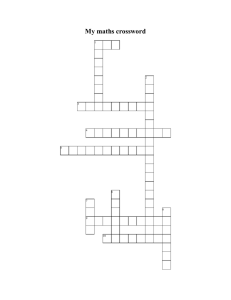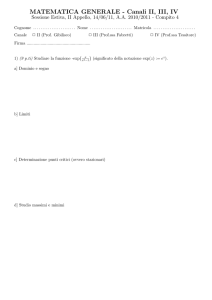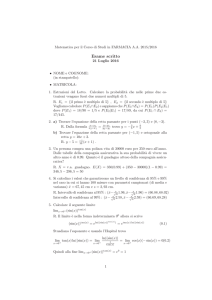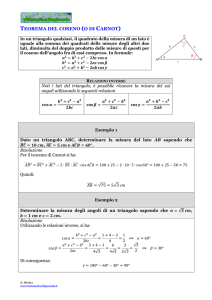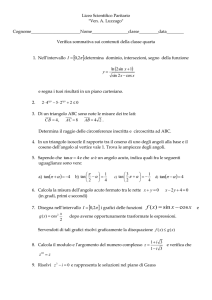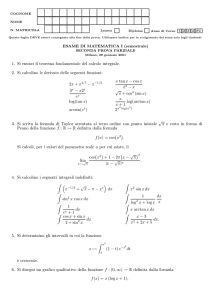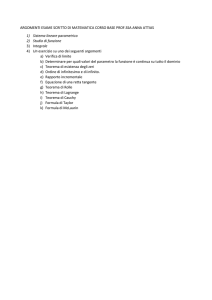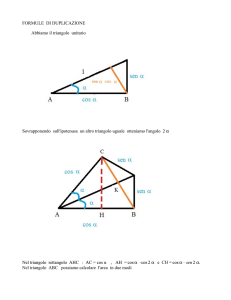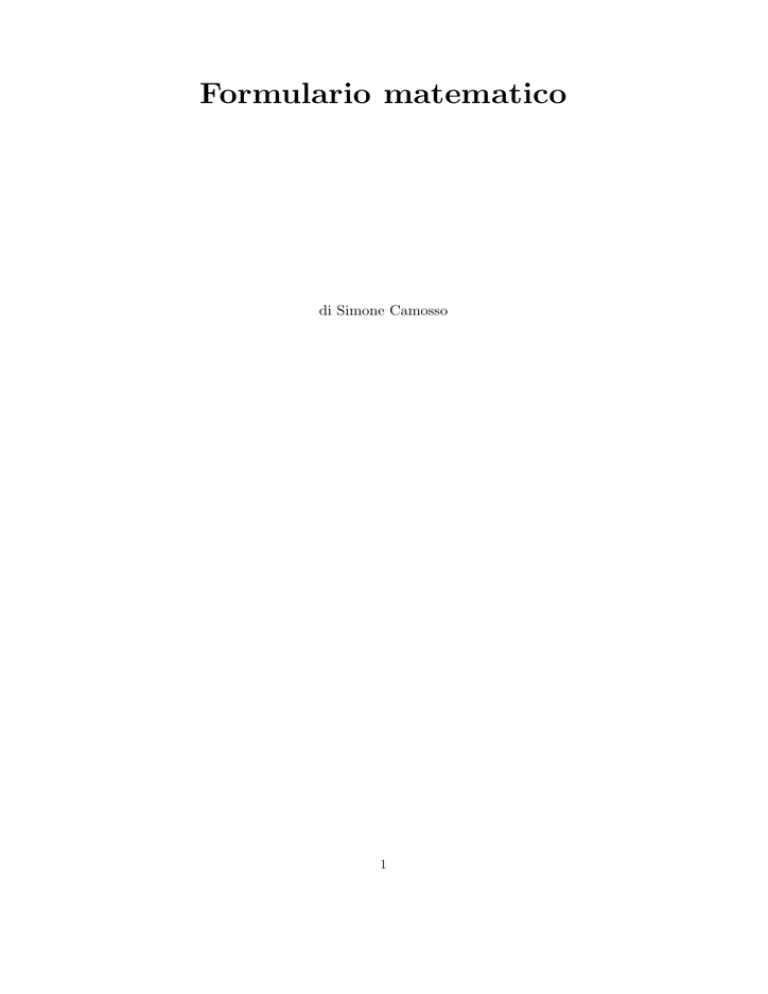
Formulario matematico
di Simone Camosso
1
Formulario matematico (di Simone Camosso)
0.1
Costanti matematiche
costante
e
π
log10 (2)
log10 (e)
loge (2)
loge (π)
loge (10)
√
2
√
e
√
3
√
π
√
5
√
10
◦
1
1 radiante
0.2
valore approssimato
2.7182818285 · · ·
3.1415926536 · · ·
0.3010299957 · · ·
0.4342944819 · · ·
0.6931471806 · · ·
0.1.1447298858 · · ·
2.3025850930 · · ·
1.4142135624 · · ·
1.6487212707 · · ·
1.7320508076 · · ·
1.7724538509 · · ·
2.2360679775 · · ·
3.1622776602 · · ·
0.0174532925 · · · radianti
57◦ 170 4400 .806 · · ·
Algebra
Regola dei segni
·
+
−
+
+
−
−
−
+
Operazioni con le frazioni
x·z
x z
· =
y w
y·w
x
z
w·x±y·z
± =
y w
y·w
x t
:
=
y w
x
y
t
w
=
x w
·
y t
µ ¶z
z
x t
xt
= z
y
yt
condizioni di esistenza
√
x
log x
1
P (x) polinomio
P (x)
arcsin x
arccos x
−1 ≤ x ≤ 1
−1 ≤ x ≤ 1
Potenze
a0 = 1
(−a)n
x≥0
x>0
P (x) 6= 0
½
=
an
n pari
n
−(a ) n dispari
10 = 1
Definizione di modulo
½
|x| =
Proprietà valore assoluto
|x
¯ ¯+ y| ≤ |x| + |y|
¯x¯
|x|
=
¯y¯
|y|
Potenze
am · an = an+m
am
= am−n
an
(am )n = am·n
(a · b)n = an · bn
¡ a ¢n
n
= abn
b
x
−x
x≥0
x<0
|x − y| ≥ ||x| − |y||
|x| ≤ y ⇔ −y ≤ x ≤ y
|x · y| = |x| · |y|
|x| = 0 se x = 0
Logaritmi
loga (a) = 1
logb (a) = log1 (b)
a
logb (x · y) = logb (x) + logb (y)
³ ´
logb xy = logb (x) − logb (y)
Teoremi sui logaritmi
loga (b) = logan (bn ), loga (b) =
logb (xy ) = y logb (x)
logc (b)
logc (a) ,
loga
Prodotti
notevoli
(x + y)2 = x2 + 2x · y + y 2
(x + y)3 = x3 + 3x2 · y + 3x · y 2 + y 3
(x − y)2 = x2 − 2x · y + y 2
(x − y)3 = x3 − 3x2 · y + 3x · y 2 − y 3
(x + y) · (x − y) = x2 − y 2
2
³√ ´
n
b =
1
n
Radicali
√
√ m
m
n
m
x = ( n x) = x n
p
√
√
n m
x = n·m x
q
√
n
n x = √x
ny
y
q √
q √
p
√
x+ x2 +y
x− x2 +y
x± y =
±
2
2
√ √
√
n x · y = n x · n y
loga (b), log x2 = 2 log |x|.
Prodotti notevoli
(x + y + z) · (x + y − z) = x2 + y 2 − z 2 + 2x · y
(x + y + z)2 = x2 + y 2 + z 2 + 2x · y + 2x · z + 2y · z
(x + y) · (x2 − x · y + y 2 ) = x3 + y 3
(x − y) · (x2 + x · y + y 2 ) = x3 − y 3
(x + y + z) · (x − y − z) = x2 − (y + z)2
Formula del binomio di Newton
¶
n µ
X
n
xn−k y k
(x + y) =
k
n
k=0
Formula risolutiva per equazioni di secondo grado ax2 + bx + c = 0
√
−b ± b2 − 4ac
x1,2 =
2a
Determinante di una matrice (2, 2)
¯
¯
¯ x y ¯
¯=x·w−y·z
det A = ¯¯
z w ¯
Determinante di una generica matrice A = (aij )
det A =
n
X
(−1)i+j aij det Aij
j=1
con Aij minore dell’elemento aij .
Inversa di una matrice A
Se il determinante di A non è nullo allora esiste la matrice inversa e indicando
con ∆ij = (−1)i+j det Aij il cofattore dell’elemento aij si ha che
A−1 =
1
(∆ji )
det A
Teorema di Binet
det A · B = det A · det B
Disposizioni
con ripetizione
Disposizioni semplici
Permutazioni
Combinazioni
Cn,k
√
proprietà di i = −1
i2
=
−1
i4k+2
=
−1
z
complesso
z = a + i · b,a, b ∈ R
Dn,k
Formula
Rn,k = nk
= n · (n − 1) · · · (n − k + 1)
Dn,n = n!
µ
¶
n
Dn,k
n!
= k! = k!(n−k)! =
k
i4k = 1
= −i
i4k+3
i4k+1 = i
√
√
−x = i x
z = ρ · (cos θ + i · sin θ) e ρ =
3
√
¡ ¢
a2 + b2 , θ = arctan ab
z = ρ · eiθ
0.3
Geometria
Formula per la distanza tra due punti P1 (x1 , y1 ), P2 (x2 , y2 )
d(P1 , P2 ) =
p
(x2 − x1 )2 + (y2 − y1 )2
Similitudine
La similitudine è una particolare trasformazione geometrica, contenuta nel piano o
nello spazio, che conserva i rapporti tra le distanze. Questo vuol dire che, per ogni
similitudine f , esiste un numero reale positivo k tale che
d(f (A), f (B)) = kd(A, B)
per ogni coppia di punti (A, B).
Criteri di congruenza per triangoli
1)Due triangoli sono congruenti se hanno congruenti due lati e l’angolo compreso
tra essi equivalente.
2)Due triangoli sono congruenti se hanno congruenti un lato e i due angoli a esso
adiacenti (ALA).
3)Due triangoli sono congruenti se hanno tutti i lati ordinatamente
congruenti (LLL).
Criteri di similitudine per triangoli
1)Se un triangolo ha gli angoli congruenti agli angoli di un altro triangolo,
allora i lati di del primo sono in proporzione con i lati del secondo.
2)Se un triangolo ha un angolo congruente ad un angolo di un secondo triangolo
e i due lati di questo triangolo proporzionali ai lati corrispondenti del secondo triangolo,
allora i triangoli sono simili.
3)Se un triangolo ha i lati in proporzione con i lati di un secondo triangolo, allora i
triangoli sono simili.
Oggetto
Parallelogramma
Triangolo
Cerchio
Trapezio
Parallelepipedo rettangolare
Sfera
Cilindro
retto
Cono
retto
Piramide
retta
Tronco
di
Cono
Superficie
S =b·h
S = b·h
2
S = π · r2
S = (a+b)·h
2
S = 2(a · b + b · c + a · c)
S = 4 · π · r2
S = 2 · π · r · (r + h)
√
S = π · r · (r + h2 + r2 )
S = Sbase + a·p
2
S = π · a · (r + r0 ) + π · r2 + π · r02
4
Oggetto
Parallelepipedo rettangolare
Sfera
Cilindro
retto
Cono
retto
Piramide
retta
Tronco
di
Cono
V =
1
3
Volume
V =a·b·c
V = 43 · π · r3
V = π · r2 · h
S = 13 · π · r2 · h
V = 13 · Sbase · h
· π · h · (r2 + r02 + r · r0 )
Formula di Erone per l’area di un triangolo con semiperimetro p
S=
p
p · (p − a) · (p − b) · (p − c)
Teorema di Euclide per un triangolo rettangolo con cateti a, b, ipotenusa c e altezza h
Afferma che l’altezza del triangolo è media proporzionale alle proiezioni dei due cateti
sull’ipotenusa. Cioè indicando con n e m le proiezioni dei cateti sull’ipotenusa si ha
m:h=h:n
Teorema di Pitagora per un triangolo rettangolo con cateti a, b e ipotenusa c
c2 = a2 + b2
Formula di Eulero
Dato un poliedro convesso con f facce, v vertici e a spigoli si ha
f +v−a=2
Raggio della circonferenza inscritta e circoscritta ad un triangolo
a·b·c
√
r = Sp
r = a·b·c
4·S =
4
p·(p−a)·(p−b)·(p−c)
Area di un triangolo di vertici P1 (x1 , y1 ), P2 (x2 , y2 ), P3 (x3 , y3 )
¯
¯
1 ¯¯ x3 − x1 y3 − y1 ¯¯
A=± ¯
2 x2 − x1 y2 − y1 ¯
Formula di Brahmagupta per l’area di un quadrilatero convesso di lati a, b, c, d e
semiperimetro p
A=
p
(p − a)(p − b)(p − c)(p − d)
Definizione di modulo per un vettore ~x = (x1 , · · · , xn )
v
u n
uX
|~x| = t
x2i
i=1
5
Prodotto scalare
~x · ~y = |~x| · |~y | · cos θ
√
|~x| =
~x · ~x
~x · ~y = ~y · ~x
~x · ~x
≥
0
~x · ~y = 0 se x, y perpendicolari
(a~x + b~y ) · ~z = a~x · ~z + b~y · ~z
Prodotto
vettoriale
|~x ∧ ~y | = |~x| · |~y | · | sin θ|
|~x ∧ ~y |2 = |~x|2 · |~y |2 − (~x · ~y )2
~x ∧ ~y
=
−~y ∧ ~x
~x ∧ (a~y + b~z) = a~x ∧ ~y + b~x ∧ ~z
Oggetto del piano
Retta
Circonferenza
~x ∧ ~y = ~0 per x, y paralleli
~i ~j ~k
~x ∧ ~y = det x1 x2 x3
y1 y2 y3
~x ∧ (~y ∧ ~z) = (~x · ~y )~y − (~x · ~y )~z
~x ∧ (~y ∧ ~z) + ~y ∧ (~z ∧ ~x) + ~z ∧ (~x ∧ ~y ) = ~0
Equazione
ax + by + c = 0 ∨ y = mx + q
x2 + y 2 + ax + by + c = 0
x2
a2
x2
a2
x2
Ellisse
Iperbole
Iperbole equilatera
Parabola
=1
=1
= a2
y = ax2 + bx + c
Oggetto del piano
Retta
Valori notevoli
m = −a
q = −c
b
qb
¡ a b¢
2
C = − 2 , − 2 e r = a4 +
Circonferenza
Ellisse
Iperbole
Iperbole equilatera
Parabola
y2
b2
y2
− b2
− y2
+
b2
4
−c
C = (0, 0), F1 = (−c, 0), F2 = (c, 0) con c2 = a2 − b2
C = (0, 0), F1 = (−c, 0), F2 = (c, 0) con c2 = a2 + b2 , asintoti y = ± ab x
C = (0, 0), F1 = (−c, 0), F2 = (c, 0) con c2 = 2a2
¢
¡ −b 1
¢
¡
1
∆
∆
∆
V = −b
2a , − 4a , F 2a , 4a − 4a , d : y = − 4a − 4a
6
0.4
Trigonometria
Radianti
0
π
6
π
4
π
3
π
2
2π
3
3π
4
5π
6
π
7π
6
5π
4
4π
3
3π
2
5π
3
7π
4
11π
6
2π
Identità
csc α = sin1 α
sec α = cos1 α
cot α = tan1 α
sin α
tan α = cos
α
cos α
cot α = sin α
Gradi
0
sin
0
30
1
√2
2
√2
3
2
45
60
90
120
135
150
180
210
225
240
270
300
315
330
360
cos
1
√
3
√2
2
2
1
2
1
0
√
3
√2
2
2
1
2
− 21
√
2
√2
− 23
−
0
−1
√
− 22
√
− 23
√
3
√2
− 22
− 21
√
− 23
√
− 22
− 12
1
√2
2
√2
3
2
− 12
−
−1
0
0
1
Relazioni tra angoli
¡
¢
cos π2 − α = sin α
¡
¢
sin π2 − α = cos α
¡
¢
tan π2 − α = cot α
¡π
¢
cot 2 − α = tan α
sin (−α) = − sin α
Relazioni di Pitagora
cos2 (α) + sin2 (α) = 1
cosh2 (α) − sinh2 (α) = 1
1 + tan2 (α) = sec2 (α)
tan
0
√
3
3
1
√
3
non definita
√
− 3
−1
√
− 33
0
√
3
3
1
√
3
non definita
√
− 3
−1
√
− 33
0
Relazioni tra angoli
cos (−α) = cos α
tan (−α) = − tan α
cot (−α) = − cot α
sec (−α) = sec α
csc (−α) = − csc α
Formule di duplicazione
sin (2α) = 2 sin α cos α
cos (2α) = cos2 (α) − sin2 (α)
2 tan α
tan (2α) = 1−tan
2 (α)
1 + cot2 (α) = csc2 (α)
7
Funzioni iperboliche
α
−α
sinh α = e −e
2
α
−α
cosh α = e +e
2
sinh α
tanh α = cosh
α
α
coth α = cosh
sinh α
Formule¡ di¢ bisezione
α
cos2 α2 = 1+cos
2
¡ ¢ 1−cos
α
2 α
sin ¡ 2 ¢ =
2
α
tan2 α2 = 1−cos
1+cos α
Formule
di
addizione
sin (α ± β) = sin α cos β ± sin β cos α
cos (α ± β) = cos α cos β ∓ sin α sin β
tan α±tan β
tan (α ± β)
=
1∓tan α tan β
Formule di Werner
sin α cos β = 12 [sin (α + β) + sin (α − β)
cos α sin β = 12 [sin (α + β) − sin (α − β)
cos α cos β = 12 [cos (α + β) + cos (α − β)
sin α cos β = 12 [cos (α − β) − cos (α + β)
Formule
di
¢
¡
¢
¡ prostaferesi
sin α + sin β = 2 sin ¡12 (α + β) ¢ cos ¡ 12 (α − β)¢
sin α − sin β = 2 cos 12 (α + β) sin 12 (α − β)
¡
¢
¡
¢
cos α + cos β = 2 cos 12 (α + β) cos 12 (α − β)
¡
¢
¡
¢
cos α − cos β = 2 sin 21 (α + β) sin 12 (α − β)
Teorema sei seni
sin β
sin γ
sin α
a = b = c
Formule di triplicazione
sin 3α = 3 sin α − 4 sin3 α
cos 3α = 4 cos3 α − 3 cos α
α−tan3 α
tan 3α = 3 tan
1−3 tan2 α
c2
Formule di Eulero
eiα = cos α + i sin α
e−iα = cos α − i sin α
iα
−iα
cos α = e +e
2
iα
−iα
sin α = e −e
2i
Teorema del coseno
= a2 + b2 − 2ab cos γ
Area di un triangolo qualunque
S = 12 ab sin γ
S = 12 bc sin α
S = 12 ac sin β
(In un triangolo qualunque si indichi i lati a, b, c, gli angoli angoli opposti rispettivamente α, β, γ)
8
0.5
Analisi matematica
f0
f
k
xn
0
nxn−1
|x|
x
1
x
ex
|x|
log x
ex
sin x
cos x
ax
tan x
cot x
sinh x
cosh x
tanh x
coth x
arcsin x
cos x
− sin x
ax log a
1
= 1 + tan2 x
cos2 x
− sin12 x
cosh x
sinh x
1
cosh2 x
− sinh12 x
√ 1
1−x2
1
− √1−x
2
1
1+x2
arccos x
arctan x
log | sin x|
log | cos x|
− cot x
tan x
Regole di derivazione
D(λf (x) ± µg(x)) = λDf (x) ± µDg(x)
D(f (x)g(x)) = [Df (x)] g(x) + [Dg(x)] f (x)
µ
D
f (x)
g(x)
¶
=
[Df (x)] g(x) − [Dg(x)] f (x)
g(x)2
D(f (x) ◦ g(x)) = D(f (g(x))) = Df (g(x))Dg(x)
Def (x) = ef (x) Df (x)
D log |f (x)| =
g(x)
Df (x)
g(x)
= f (x)
Df (x)
f (x)
¾
½
g(x)Df (x)
Dg(x) log f (x) +
f (x)
9
R
f
k
xn
x|x|
2
|x|
log x
ex
sin x
cos x
ax
+c
log |x| + c
ex + c
− cos x + c
sin x + c
ax
log a + c
tan x + c
− cot x + c
cosh x + c
sinh x + c
arcsin x + c
1
cos2 x
1
sin2 x
sinh x
cosh x
√ 1
1−x2
1
− √1−x
2
1
1+x2
1
cosh2 x
√ 1
1+x2
√ 1
x2 −1
1
1−x2
1
1−x2
f
ex
sin x
cosh x
log (x + 1)
1
1+x
arctan x
arctan x + c
tanh x + c
√
log (x + x2 + 1) + c
√
log (x + x2 − 1) + c
log x+1
x ∈ (−1, 1)
1−x + c
x+1
1
x > 1 ∨ x < −1
2 log x−1 + c
1
2
x3
3!
Sviluppo
2
n
1 + x + x2! + ... + xn! + o(xn )
5
x2n+1
+ x5! + ... + (−1)n (2n+1)!
+ o(x2n+1 )
x2
x4
n x2n
2n
2 + 4! + ... + (−1) (2n)! + o(x )
3
5
x2n+1
x + x3! + x5! + ... + (2n+1)!
+ o(x2n+1 )
2
4
x2n
1 + x2 + x4! + ... + (2n)!
+ o(x2n )
2
3
n+1
x − x2 + x3 + ... + (−1)n xn+1 + o(xn+1 )
+ αx + α(α−1)
x2 + ... + α(α−1)(α−2)....(α−n+1)
xn + o(xn )
2
n!
2
3
4
5
n
n
1 − x + x − x + x − x + ... + (−1) x + o(xn )
1−
sinh x
(1 + x)α
arccos x + c
x−
cos x
f dx
kx + c
xn+1
n+1 + c
1
x−
x3
3
2n+1
+ · · · + (−1)n x2n+1 + o(x2n+1 )
Formula di Taylor
f (x) =
∞
X
f (n) (x0 )
n=0
n!
10
(x − x0 )n
Operazioni in R = R ∪ {±∞}
+∞ + ∞
=
+∞
(+∞) · (+∞)
=
+∞
(+∞) · (−∞) = (−∞) · (+∞) = −∞
x
x
= 0
= 0
+∞
−∞
x
per ogni x ∈ R, x > 0 ho 0 = +∞
−∞ − ∞ = −∞
(−∞) · (−∞) = +∞
x + ∞ = +∞ + x = +∞ con x ∈ R
se x > 0 ho x · (+∞) = +∞ e x · (−∞) = −∞
per ogni x < 0 ho x0 = −∞
Forme indeterminate
+∞
∞
+∞ − ∞
00
1±∞
log0 (0)
log1 (1)
Limiti
limx→0
limx→0
∞
−∞
0 · (+∞)
∞0
0
0
log∞ (0)
log∞ (∞)
fondamentali
=
1
1
=
2
sin x
x
1−cos x
x2
limx→0 tanx x = 1
£
¤x
limx→+∞ 1 + x1 = e
1
limx→0 [1 + x] x
=
e
ax −1
limx→0 x
=
loge a
x
limx→0 arctan
=
1
x
√
x
limx→+∞ x
=
1
β
limx→+∞ xax
limx→+∞
limx→0 loge (1+x)
=1
x
arcsin x
limx→0 x = 1
x
limx→0 1−cos
=0
x
logα x
= 0 con β > 0, α > 0, α 6= 1
xβ
= 0 se a > 1 e β ∈ R
limx→+∞
Sostituzione per integrali trigonometrici
t = tan
x
1 − t2
2t
cos x =
sin x =
2
2
1+t
1 + t2
x = 2 arctan t dx =
2
dt
1 + t2
Formula di integrazione per parti
Z
Z
f Dgdx = f g − Df gdx
Regole di derivazione per vettori
Dt (~x(t)) =
n
X
Dt xi (t)~ei
i=1
Dt (~x(t) · ~y (t)) = [Dt ~x(t)] · ~y (t) + [Dt ~y (t)] · ~x(t)
11
x!
xx
=0
Dt (f (t)~x(t)) = [Dt f (t)] ~x(t) + [Dt ~x(t)] f (t)
Dt (~x(t) + ~y (t)) = Dt ~x(t) + Dt ~y (t)
Dt (~x(t) ∧ ~y (t)) = [Dt ~x(t)] ∧ ~y (t) + [Dt ~y (t)] ∧ ~x(t)
Dt ~x(u(t)) = Du ~x(u(t))Dt u(t)
coordinate ½
polari:
cilindriche:
sferiche:
Jacobiano
x = ρ cos θ
y = ρ sin θ
x = ρ cos θ
y = ρ sin θ
z=z
x = ρ sin ϕ cos θ
y = ρ sin ϕ sin θ
z = ρ cos ϕ
ρ
ρ
ρ2 sin ϕ
Operatori vettoriali in R3
Gradiente grad(f ) = ∇f =
∂f ~
∂x i
Divergenza div(F~ ) = ∇ · F~ =
2
2
Laplaciano ∆f = ∂∂xf2 + ∂∂yf2
¯
¯ ~i
~j
¯
~
¯
Rotore ∇ × F = ¯ ∂x ∂y
¯ Fx Fy
+
∂Fx
∂x
+
~k
∂z
Fz
∂f ~
∂y j
+
+
∂Fy
∂y
∂f ~
∂z j
+
∂Fz
∂z
∂2f
∂z 2
¯
¯
¯
¯.
¯
¯
Operatori vettoriali in coordinate cilindriche
Gradiente grad(f ) = ∇f =
∂f
eρ
∂ρ ~
+
1 ∂f
eθ
ρ ∂θ ~
+
∂f
ez
∂z ~
∂(ρF )
θ
Divergenza div(F~ ) = ∇ · F~ = ρ1 ∂ρ ρ + ρ1 ∂F
∂θ +
³
´
∂2f
∂
1 ∂2f
Laplaciano ∆f = ρ1 ∂ρ
ρ ∂f
∂ρ + ρ2 ∂θ2 + ∂z 2
¯
¯
¯ ~eρ ρ~eθ ~ez ¯
¯
¯
Rotore ∇ × F~ = ¯¯ ∂ρ ∂θ ∂z ¯¯.
¯ Fρ ρFθ Fz ¯
Operatori vettoriali in coordinate sferiche
Gradiente grad(f ) = ∇f =
∂f
eρ
∂ρ ~
+
1 ∂f
eθ
ρ sin ϕ ∂θ ~
12
+
∂Fz
∂z
1 ∂f
eϕ
ρ ∂ϕ ~
Divergenza div(F~ ) = ∇ · F~ =
Laplaciano ∆f =
∂2f
∂ρ2
2 ∂f
ρ ∂ρ
+
∂Fρ
∂ρ
1
ρ2
+
h
+ ρ2 Fρ + ρ1
h
2
1 ∂Fθ
sin ϕ ∂θ
+
2
∂ f
1
(sin ϕ)2 ∂θ2
∂Fϕ
∂ϕ
i
+ cot ϕFϕ
i
∂ f
∂f
+ ∂ϕ
2 + cot ϕ ∂ϕ
¯
¯
~eθ
¯
¯.
∂θ
¯
ρ sin ϕFθ ¯
¯
¯ ~eρ ρ~eϕ
¯
1
Rotore ∇ × F~ = ρ2 sin ϕ ¯¯ ∂ρ ∂ϕ
¯ Fρ ρFϕ
Formule di Gauss in Rn
Ω dominio limitato, con frontiera regolare ∂Ω e normale esterna ~ν . ~u, ~v campi vettoriali regolari fino alla frontiera di Ω. ϕ, ψ campi scalari regolari fino alla frontiera di
Ω. dσ elemento di superficie su ∂Ω.
Z
Z
∇ · ~udx =
~u · ~ν dσ
Ω
∂Ω
Z
Z
∇ϕdx =
ϕ~ν dσ
Ω
Z
∂Ω
Z
Z
∆ϕdx =
∇ϕ · ~ν dσ =
Ω
∂Ω
∂Ω
∂~ν ϕdσ
Integrazione per parti:
Z
Z
Z
ψ∇ · F~ dx =
ψ F~ · ~ν dσ −
Ω
∂Ω
∇ψ · F~ dσ
Ω
Prima identità di Green:
Z
Z
ψ∆ϕdx =
Ω
∂Ω
Z
ψ∂~ν ϕdσ −
∇ϕ · ∇ψdx
Ω
Seconda identità di Green:
Z
Z
ψ∆ϕ − ϕ∆ψdx =
Ω
∂Ω
ψ∂~ν ϕ − ϕ∂~ν ψdσ
Formule di Stokes in R3
Sia S una superficie regolare, il cui bordo è una linea regolare C, ~ν il versore normale
ad S, ~t versore tangente a C, tali che C sia orientata positivamente rispetto a S, ds
l’elemento di lunghezza su C e dσ l’elemento di superficie su S. Vale:
13
Z
Z
~u · ~tds
∇ × ~u · ~ν dσ =
S
C
Identità
∇ · (∇ × ~u) = 0
∇ × ∇ϕ = ~0
∇ · (ϕ~u) = ϕ∇ · ~u + ∇ϕ · ~u
∇ × (ϕ~u) = ϕ∇ × ~u + ∇ϕ × ~u
∇ × (~u × ~v ) = (~v · ∇)~u − (~u∇)~v + (∇ · ~v )~u − (∇ · ~u)~v
∇ · (~u × ~v ) = (∇ × ~u) · ~v − (∇ × ~v ) · ~u
∇(~u · ~v ) = ~u × (∇ × ~v ) + ~v × (∇ × ~u) + (~u · ∇)~v + (~v ∇)~u
(~u · ∇)~u = (∇ × ~u) × ~u + 12 ∇|~u|2
∇ × ∇ × ~u = ∇(∇ · ~u) − ∆~u
Equazione del piano tangente in R3 alla superficie z = f (x, y) in (x0 , y0 )
z = f (x0 , y0 ) +
Equazione
y 0 (t)
−
∂f
∂f
(x0 , y0 )(x − x0 ) +
(x0 , y0 )(y − y0 )
∂x
∂y
differenziale
a(t)y(t)
=
b(t)
y(t) = e
ax00 (t) + bx0 (t) + cx(t)
=
0
2
polinomio caratteristico: (aλ + bλ + c = 0)
ax00 (t) + bx0 (t) + cx(t)
Serie
P+∞ 1
nα
Pn=0
+∞ n
x
Pn=0
+∞
an
Pn=0
+∞
n=0 an
se limn→+∞
se limn→+∞
λ1,2
=
f (t)
Formula
nR
a(t)dt
R
b(t)e−
R
a(t)dt dt
o
+c
λ1 6= λ2 , x(t) = c1 eλ1 t + c2 eλ2 t
λ1 = λ2 , x(t) = (c1 + c2 t)eλ1 t
= α ± iβ, x(t) = eαt [c1 sin βt + c2 cos βt]
metodo di variazione delle costanti
Convergenza
se α > 1 converge altrimenti diverge
1
se |x| < 1 converge a 1−x
an+1
an = l < 1 allora converge, se > 1 diverge, se = 1 caso dubbio
√
n a = l < 1 allora converge, se > 1 diverge, se = 1 caso dubbio
n
Formule per le serie
PN
xN +1 −1
n
se |x| < 1
n=0 x =
x−1
PN
N (N +1)
n=
2
Pn=1
N
n = (N − 1)2n+1 + 2
n2
n=0
14
Variabile
Bernoulli
casuale
X(θ)
Binomiale
Yn (θ)
Poisson
Geometrica
Distribuzione
PX (k) = θk (1 − θ)1−k
µ
¶
n
PYn (k) =
θk (1 − θ)n−k
k
k
PX (k) = λk! e−λ
PX (k)= θ(1
− θ)k−1
m n − m
k
r−k
PX (k) =
n
r
X(λ)
X(θ)
Ipergeometrica
X,
r
campione,
n totale popolazione e m parte di popolazione
Variabile casuale continua
Uniforme
X
Normale
X(µ, σ 2 )
Esponenziale
Gamma
Densità
½ 1
b−a a < x < b
fX (x) =
0 altrimenti
(x−µ)2
fX (x) = √ 1 2 e− 2σ2
½ 2πσ
1 − xθ
x>0
θe
fX (x) =
0 altrimenti
(
x
1
α−1 e− β x > 0
α Γ(α) x
β
fX (x) =
0 altrimenti
X(θ)
X(α, β)
sistemi lineari a coefficienti variabili
~y 0 (x)
=
A(x)~y (x)
0
~y (x)
=
A(x)~y (x) + f~(x)
(n)
(n−1)
y (x) = a1 (x)y
(x) + · · · + an (x)y(x) + f (x)
0
1 ··· 0
0
0
0
1
0
A
=
..
..
..
..
..
.
.
.
.
.
an (x) · · ·
···
···
a1 (x)
~y (x) = W (x)~c con w(x) = det W (x)
Rx
sol. omogenea +W (x) x W −1 (t)f (t)dt
pongo ~y = (y, y 0 , · · · , y (n−1) ),
0
..
.
~
f (x) =
..
.
f (x)
Proprietà di W
1)W 0 (x) = A(x)W (x).
2)Condizione necessaria e sufficiente affinché y 1 , · · · , y n sia un sistema fondamentale
di soluzioni è che w(x) 6= 0 in un punto x0 di I.
3)Sia x ∈ I, il valore del wronskiano w(x) è dato per ogni x da
w(x) = w(x)e
Rx
x
tr(A)(t)dt
equazioni (ordine n) y (n) (x) = a1 (x)y (n−1) (x) + · · · + an (x)y(x) + f (x)
15
¯
¯ z1 (x)
···
zn (x)
¯
..
..
..
¯
Sef (x) = 0 utilizzo il risultato:n soluz. sono l.i. se e solo se W (x) = ¯
.
.
.
¯ (n−1)
(n−1)
¯ z
(x) · · · zn
(x)
1
0 in un punto x0 ∈ I. Quindi y(x) = c1 z1 (x) + · · · + cn zn (x). Nel caso delle equazioni
lineari di ordine n il wronskiano è dato dalla formula
Rx
w(x) = w(x)e
x
a1 (t)dt
.
Se f (x) 6= 0 allora l’integrale generale è dato dall’integrale dell’ eq. omogenea
Rx
(x,t)
+u(x) = x w1n
w(t) f (t)dt con
¯
¯
¯ z1 (t) · · · · · ·
zn (t) ¯¯
¯
..
..
..
..
¯
¯
¯
¯
.
.
.
.
w1n (x, t) = ¯ (n−2)
¯
(n−2)
¯ z
· · · · · · zn
(t) ¯¯
¯ 1
¯ z (x) · · · · · ·
zn (x) ¯
1
sistemi lineari a coefficienti costanti
~y 0 (t)
=
A(x)~y (t)
0
~y (x)
=
A(x)~y (x) + f~(x)
calcolo
Autovalori
eAt
regolari
Autovalori regolari (R, C)
Autovalori
multipli
³
´
k−1 tk−1
· In + N t + · · · + N (k−1)!
~x(t) = eAt ~x0
Rt
sol. omogenea + 0 eA(t−s) f (s)ds
eAt = Sdiag[eλj t ]S −1
µ
¶¸
cos bj t − sin bj t
At
λ
t
a
t
j
j
e = Sdiag e , e
S −1
sin bj t cos bj t
·
µ
¶¸
cos bj t − sin bj t
At
λ
t
a
t
j
j
e = Sdiag e , e
S −1 ·
sin bj t cos bj t
·
S è la matrice degli autovettori corrispondenti agli autovalori, N è nilpotente con
ordine ≤ n ed è legata alla relazione A = P + N con P = Sdiag[λj ]S −1 . Per la
ricerca di autovettori generalizzati si procede con l’algoritmo:
(A − λIn )~u1 = ~u, (A − λIn )~u2 = ~u1 , · · · .
Teorema
Sia ~x˙ = A~x un sistema lineare con A matrice quadrata di ordine n. Se A non è
singolare ~x = ~0 è l’unico punto di equilibrio. Siano λ1 , · · · , λn gli autovalori di A,
ciascuno contato in accordo alla propria molteplicità, allora
1)~0 è asintoticamente stabile se e solo se tutti gli autovalori hanno parte reale negativa. La stabilità è globale in Rn .
2)~0 è stabile (non asintoticamente) se e solo se tutti gli autovalori hanno parte reale
≤ 0 e gli autovalori con parte reale nulla sono regolari.
16
¯
¯
¯
¯
¯ 6=
¯
¯
3)~0 instabile per tutti gli altri casi.
Stabilità
in (0, 0)
½
ẋ = ax + by
ẏ = cx + dy
Traiettorie
Equazione caratteristica
per gli autovalori
Serie
f (t) =
an
f
f
in
dy
dx
cx+dy
= ax+by
λ2 − (tr(A))λ + det A = 0
∆ > 0, soluzioni con stesso segno: nodo a due tangenti,
stabile se negativi, instabile se positivi.
Soluzioni con segno opposto: colle.
∆ = 0, se esistono due autovettori l.i.
l’origine è un nodo a stella altrimenti
un nodo a tangenti.
∆ < 0, soluzioni immaginarie pure: è un centro, stabile.
Altrimenti è un fuoco .
Fourier
+ n=1 an cos nω0 t + bn sin nω0 t
R
1 I
=
I −I f (t) cos nω0 tdt
pari
dispari
forma
esponenziale
a0
2
di
P+∞
17
RI
T = 2I, a0 = I1 −I f (t)dt
RI
bn = I1 −I f (t) sin nω0 tdt
RI
bn = 0 e an = I1 0 f (t) cos nω0 tdt
RI
an = 0 e bn = I1 0 f (t) sin nω0 tdt
P
inωt
f (t) = +∞
n=−∞ cn e
R
I
cn = I1 −I f (t)e−inωt dt
ω0 =
2π
T ,
Trasformata
di
Fourier
R +∞
F[f ; ω] = F[f ] = −∞ f (t)e−iωt dt
Trasformata di Laplace
R +∞
L[f, p] = L[f ] = 0 e−pt f (t)dt
f
f (t − a)
eiω0 t f (t)
tf (t)
f 0 (t)
1
1+t2
1
a2 +t2
e−|t|
e−t
Antitrasformata
R +∞ iωξ
1
F −1 F[f ; ω] = f (t) = 2π
F(ω)dω
−∞ e
Antitrasformata
R k+i∞ pt
1
−1
L L[f, p]f (t) = 2πi
k−i∞ e L[f ]dp
Trasformata di Fourier
e−iωa F[f ](ω)
F[f ](ω − ω0 )
d
F[f ](ω)
i dω
iωF[f ](ω)
πe−|ω|
π −a|ω|
ae
2
−at2
e
χ[−a,a] (t)
f ∗ g(t)
f (t)g(t)
2
1+ω 2
√ − ω2
4
πe
p π − ω2
4a
ae
sin aω
2 ω
F[f ](ω) · F[g](ω)
1
2π F[f ](ω) ∗ F[g](ω)
Spazi funzionali
p
Lp (A) = L©≈(A)
ª
R
con Lp = f : A → C|f misurabile A |f |p dµ < +∞
e f ≈ g ⇔ ©µ ({x ∈ A|f (x) 6= g(x)}) = 0 ⇔ f = Rg q.o..
ª
L1loc (A) = f : A → C|∀K ⊂ A K compatto K |f |dµ < +∞
E(Ω) = C ∞ (Ω) con ω ⊆ Rn .
D(Ω) = {f : Ω → C|f ∈ C ∞ e il supporto è compatto } = C0∞ .
S(Rn ) = {f ∈ C ∞ (Rn )|∀α, β ∈ (Z+ )n supx∈Rn |xβ ∂ α f (x)| < +∞}
D0 (Ω) = {u ∈ (D(Ω))∗ : ∀{ϕj }j∈N ⊂ D(Ω) t.c. ϕj → 0 ⇒ u(ϕj ) → 0}
S 0 (Rn ) = {u : S(Rn ) → C| lineare e continua}.
Convoluzione
R
f ∗ g = Rn f (x − y)g(y)dy
Lp (Rn )
18
f, g : Rn → C
con ∗ è commutativo, associativo e distributivo
Trasformata di Fourier in Rn
R
[F(f )] (ξ) = fb = e−ixξ f (x)dx
Trasformata di Fourier in L2 (Rn )
fk ∈ L1 (Rn ) ∩ L2 (Rn ), fbk → fb
Proprietà
αf
d
D
=
(iξ)α fb
R
R
bbdx
=
n f gdx
n fg
R
f ∈ L1 (Rn )
R ixξ
1
f (x) = (2π)
e fb(ξ)dξ.
n
1
n
f ∈ L (R ) ∩ L2 (Rn )
f, g ∈ L2
n
\
f, g ∈ L1 , (f
∗ g) = (2π) 2 fbgb
R
Convergenza
Puntuale di funzioni
Uniforme di funzioni(1)
Uniforme di funzioni(2)
Puntuale di serie
Uniforme di serie
∀x ∈ I∃ limn→+∞ fn (x)
∀ε > 0∃N = N (ε) : n > N ⇒ |fn − f (x)| < ε, ∀x ∈ I
limn→+∞ supx∈I |fn (x)
Pn− f (x)| = 0
∀x ∈ I∃ limn→+∞
n=0 fn (x)
P
limm→+∞ supx∈I | m
f
(x) − f (x)| = 0
n
n=0
Integrali definiti notevoli
√
R +∞ − x2
2 dx
2π
=
−∞ e
R +∞ x
π2
=
ex −1 dx
6
0
R +∞ sin x
= π
x dx
R−∞
+∞ z−1 −x
x e dx = Γ(z)
0
R +∞
√
π
2
R0 +∞ sin x
π
x dx = 2
0
π
R2
π
0 ln cos xdx = − 2 ln 2
2
e−x dx =
funzione gamma
Equazioni differenziali alle derivate parziali
Laplace
Calore
Onde
Schrödinger
Trasporto
19
∆u = 0
ut − ∆u = 0
utt − ∆u = 0
iuP
t + ∆u = 0
ut + ni=1 bi uxi = 0
Formula
di
R f (z)
1
I(γ, a)f (a) = 2πi
γ z−a dz
R
f (z)
n!
n
f (a) = 2πi γ (z−a)n+1 dz
Cauchy
Formula di Cauchy per le derivate
∂f
∂x
+ i ∂f = 0
P+∞ ∂y
f (z) = n=−∞ cn (z − z0 )n
Condizioni di Cauchy Riemann
Serie
di
Laurent
R
f (z)
1
cn
=
2πi γ (z−z0 )n+1 dz
Residuo
di
f
Residuo
all’infinito
Residuo per un polo di ordine 1
R
1
Res(f ) = c−1 = 2πi
γ f (z)dz
−c−1
Res(z0 ) = limz→z0 (z − z0 )f (z)
d n−1
[(z − z0 )f (z)]
dz
0)
Res(f, z0 ) = QP0(z
R
Pn (z0 )
i=1 Res(f, zi )
γ f (z)dz = 2πi
Residuo per un polo di ordine n
Se
f (z)
Teorema
=
dei
Res(z0 ) =
P (z)
Q(z)
residui
1
(n−1)!
limz→z0
n numero punti singolari in γ
Disuguaglianze
Cauchy
Young
Cauchy-Schwarz
Hölder
Minkowski
2
2
ab ≤ a2 + b2 a, b ∈ R
q
ab ≤ p + bq a, b ∈ R con p1 + 1q = 1.
|~x · ~y | ≤ |~x||~y | ~x, ~y ∈ RnR
1
1
se 1 ≤ p, q ≤ ∞ p + q = 1, u ∈ LP , v ∈ Lq ⇒ U |uv|dx ≤k u kp k v kq
1 ≤ p ≤ ∞, u, v ∈ Lp (U ) ⇒k u + v kp ≤k u kp + k v kp
ap
Teorema di esistenza (di Peano)
Se f è continua in un aperto D ⊆ R2 e (t0 , y0 ) ∈ D, allora esiste almeno una
soluzione al problema
½ 0
y = f (t, y)
y(t0 ) = y0
Teorema di esistenza e unicità locale
Se f è continua in un aperto D ⊆ R2 , insieme a fy , allora per ogni punto (t0 , y0 ) ∈
D esiste un intorno I di t0 , in cui è definita la soluzione di
½ 0
y = f (t, y)
y(t0 ) = y0
Teorema di esistenza e unicità locale in Rn
Se f~ è continua in un aperto D ⊆ Rn+1 , insieme a
soluzione (locale) di
½ 0
~y = f~(t, ~y )
~y (t0 ) = ~y0
20
∂ f~
∂yi
con i = 1, · · · , n, allora la
è unica.
Teorema di esistenza e unicità globale
Siano S = (a, b) × R ed f definita in S = [a, b] × R soddisfacente il teorema di
esistenza e unicità locale in S. Se
1. ∃h, k tali che |f (t, y)| ≤ h + k|y| ∀(t, y) ∈ S.
2. f è limitata in S,
3. fy è limitata in S e f (t, 0) è limitata in [a, b].
Allora y 0 = f (t, y) ha soluzione definita su tutto [a, b] cioè su R.
Teorema di esistenza e unicità globale in Rn
Siano S = (a, b) × Rn ed f~ definita in S soddisfacente il teorema di esistenza e
unicità locale in S. Se
1. ∃h, k tali che k f~(t, ~y ) k≤ h + k k y k ∀(t, ~y ) ∈ S.
2. f~ è limitata in S, ∃M > 0 t.c. k f~(t, ~y ) k≤ M ∀(t, ~y ) ∈ S,
3. Tutte le
∂ f~
∂yi
sono limitate in S ed f~(t, ~0) è limitata in [a, b].
Allora per ogni (t0 , y0 ) ∈ S la soluzione di
½ 0
~y = f~(t, ~y )
~y (t0 ) = ~y0
esiste in tutto [a, b].
Teorema (prolungamento)
Se f (t, y) è continua con derivata parziale fy continua in un aperto D e se R è un
qualunque rettangolo chiuso contenuto in D e che contiene il punto (t0 , y0 ) allora la
soluzione del problema di Cauchy
½ 0
y = f (t, y)
y(t0 ) = y0
fornita dal teorema di esistenza ed unicità può essere estesa ad un certo intervallo
chiuso [t1 , t2 ] in modo che i punti (t1 , y(t1 )), (t2 , y(t2 )) appartengano alla frontiera del
rettangolo R.
Approssimazioni successive
Nelle ipotesi del teorema di esistenza ed unicità, la successione definita per ricorrenza da
21
½
y0 (t) = y0
Rt
yn+1 = y0 + t0 f (s, yn (s))ds
(0.5.1)
converge uniformemente alla soluzione del problema di Cauchy, in ogni intervallo
chiuso e limitato contenuto nel dominio della soluzione stessa.
Teorema di Ascoli Arzelà
Sia K un insieme compatto di Rn , sia C(K) l’insieme delle funzioni continue su
K a valori complessi (o reali) con k f kC(K) = supx∈K |f (x)|, un sottoinsieme Γ di
C(K) è relativamente compatto in C(K) se e solo se
1. le funzioni di Γ sono uniformemente limitate.
2. Le funzioni di Γ sono uniformemente equicontinue.
Osservazione 1. Una famiglia F di funzioni è detta equicontinua su un compatto
K se ∀ε > 0∀x ∈ K∃V (x)∀y ∈ V (x)∀f ∈ F :k f (y) − f (x) k≤ ε.
Proposizione (convoluzione)
1. Sia f ∈ C0k (Rn ), g ∈ L1loc (Rn ) allora f ∗ g ∈ C k (Rn ) e ∀α ∈ Zn+ , |α| ≤ k si ha
∂ α (f ∗ g) = (∂ α f ) ∗ g.
2. Se f ∈ C r (Rn ), g ∈ C s (Rn ) ⇒ f ∗ g ∈ C r+s (Rn ) in particolare ∀α, β ∈ Z+ con
|α| ≤ r, |β| ≤ s si ha ∂ α+β (f ∗ g) = (∂ α f ) ∗ (∂ β g).
Funzione di Liapunov
Sia V : D ⊆ R2 → R, V ∈ C 1 (D). Se esiste un intorno U di (0, 0) tale che
1. V (x, y) ≥ 0 in U e V (x, y) = 0 solo se (x, y) = (0, 0).
2. V̇ (x, y) = Vx (x, y)f (x, y) + Vy (x, y)g(x, y) ≤ 0 in U .
allora V si dice funzione di Liapunov per il sistema
½
ẋ = f (x, y)
ẏ = g(x, y)
(0.5.2)
Teorema
Sia (0, 0) un punto di equilibrio per il sistema
½
ẋ = f (x, y)
ẏ = g(x, y)
(0.5.3)
se esiste una funzione di Liapunov, allora (0, 0) è stabile. Se, inoltre, V̇ ≤ 0 per
(x, y) 6= (0, 0), allora (0, 0) è asintoticamente stabile.
22
Curva β(s), (param. mediante ascissa curvilinea)
Campo
tangente
Campo
normale
Campo
Torsione
binormale
T (s) = β 0 (s)
N (s) =
T 0 (s)
kT 0 (s)k
=
1
0
k(s) T (s).
B(s) = T (s) × N (s)
τ (s) = −B 0 (s) · N (s)
Superficie
ϕ(u, v)
Coefficienti della prima forma
Campo
normale
E = ϕu · ϕu , F = ϕu · ϕv , G = ϕv · ϕv
ϕu ×ϕv
N (s) = kϕ
.
u ×ϕv k
Coefficienti seconda forma
a11 =
Curvatura Gaussiana e media
l = N · ϕuu , m = N · ϕuv , n = N · ϕvv
Em−F l
Gm−F n
= EG−F
2 , a21 = EG−F 2 , a22 =
Gl−F m
, a12
EG−F 2
K=
23
ln−m2
EG−F 2
,H =
En−2F m+Gl
EG−F 2
En−F m
EG−F 2

